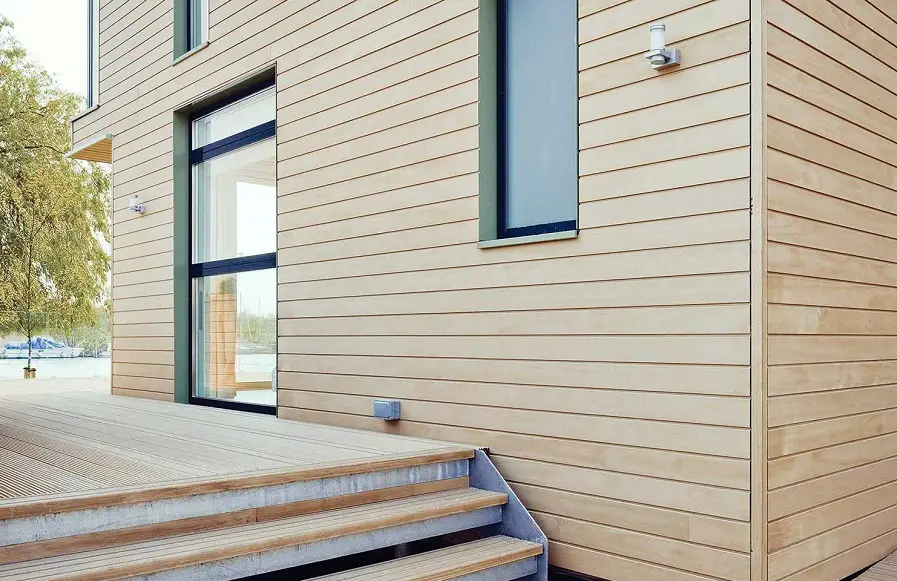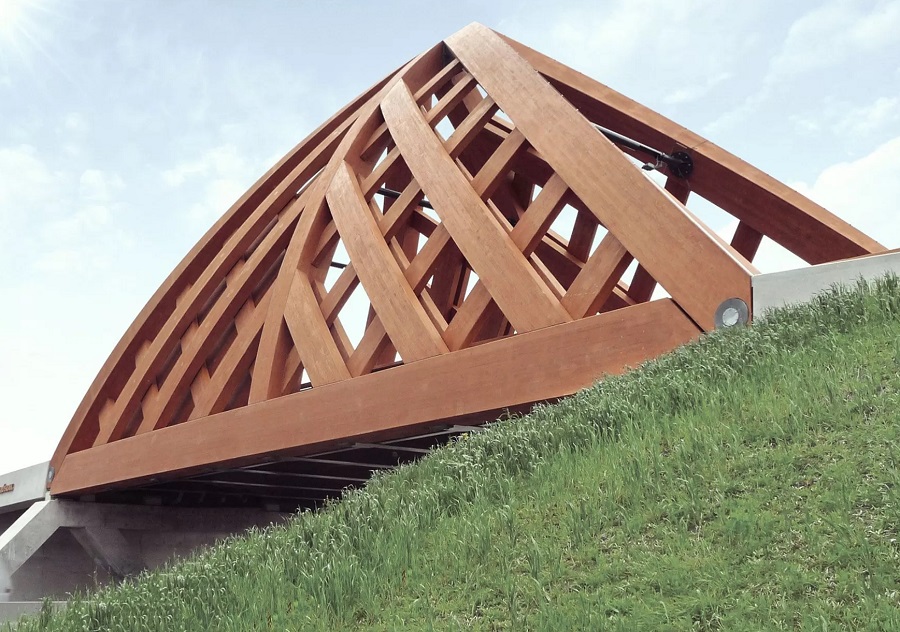Although it was and is one of the most popular materials used in construction and landscaping, wood is sometimes overlooked because of its low outdoor resistance. With the exception of a few exotic species with very high resistance to decay, which due to heavy exploitation have become endangered, wood must be protected to withstand weathering and UV radiation. The most effective materials for protecting outdoor wood do not last for more than 12-14 years, so new methods have been sought to increase its durability and have led to its impregnation with various substances. Initially, biocides were used, which were effective against mould and insects that affected the wood and reduced its strength, but were dangerous to humans. Therefore the search began for impregnation products that would leave 100% wood natural. We recently presented Kebony, made in Norway by impregnating pine wood with a liquid made from vegetable waste, a process that increases its external strength to over 30 years. This time it will be Accoya, a resinous softwood treated in an acetylation process, which results in a natural material with an external strength of up to 50 years.

What is Accoya
Accoya is a softwood treated under special conditions with acetic anhydride. What is acetic anhydride? A substance obtained by dehydrating acetic acid, an acid we all know as vinegar when its concentration is 6 or 9% in water. The treatment makes the wood much more dimensionally stable and greatly reduces its water resistance. The material is produced by Accsys Technologies PLC, based in Arnhem, the Netherlands, which also owns the brand name Accoya ®. The wood used for the acetylation comes from pine (Pinus Radiata) plantations in New Zealand.
As in the case of Kebony wood, the treatment transforms a softwood, considered softer and faster growing, into a much harder and stronger wood, comparable to that from exotic species with very good outdoor resistance such as sapeli or ipe. The transformation takes place at the cellular level, but the modification does not affect the properties of the wood as a natural material but only enhances them. Accoya is classified in strength class 1 according to EN 350-2, En 113, EN 252 and En 807.
Accoya was first featured in May 2008 in the UK on a TV show about building a house. In the same year it was used in the construction of several road bridges in the Netherlands, the largest of which has two lanes in each direction, a length of 30 m and an estimated lifespan of 80 years.

How the idea of acetylation was arrived at
Now a little chemistry will follow. Don't be scared, I promise it will be short and I will try to be as explicit as possible, as little chemistry as possible. 🙂 Wood is a non-uniform material, it is not made of simple molecules like water (H2O), let's say. Its main components are cellulose, a uniform substance with a well-defined structure and lignincomplex and uneven. These large molecules (chemists call them macromolecules) have many -OH groups (hydroxyl groups), which are very friendly to water. They are the ones that cause water to be absorbed, and it is water that is responsible for the dimensional instability of wood, cracking, warping and rotting.
Hydroxyl groups react readily with acetate groups (without acetic anhydride), which has been known for a long time. This is how cellulose acetate, the material used for photographic film in old cameras, was obtained by reacting cellulose, which is very rich in hydroxyl groups, with acetic anhydride. This gave rise to the idea of acetylating wood to make a less water-friendly product.
To obtain Accoya, the wood is treated with acetic anhydride in autoclaves under controlled temperature and pressure conditions. As a result of the process, most of the hydroxyl groups are replaced by acetyl groups, resulting in acetylated wood and acetic acid which is reintroduced into the process (from which acetic anhydride is obtained). The acetyl groups do not like water at all and so the wood no longer absorbs water, becomes more stable, more resistant to cracking and rotting, and therefore more durable. Broadly speaking, what happens can be rendered as in the chema below.

Advantages and disadvantages of Accoya wood
The first advantage to be mentioned is that Accoya is a 100% natural and non-toxic material, Acetyl groups are commonly part of wood. Let's not forget that one of the methods of obtaining vinegar is the dry distillation of wood, mmethod used in our country many years ago. Accoya waste can be recycled, burned or composted with absolutely no problem.
Its appearance is similar to untreated wood and can be mechanically processed like any other wood. Acetylation takes place in depth, not just on the surface, so there is no need to protect the fibre ends resulting from mechanical processing or wood cutting.
The dimensional stability of the material is greatly improved, being considered to be 3 times greater than ordinary wood. The tendency to crack is also greatly reduced, studies showing that water absorption in wood and cracks are reduced by 75%.
It is resistant to fungal and insect attack. The modified material is not recognised by insects (including termites) as wood and therefore they do not use it as food. Mushrooms don't do well on Accoya either because it doesn't give them the moisture they need to grow.
The biggest disadvantage is the high price of the product. The fact that the wood is sourced from controlled plantations in New Zealand (not by clearing forests) and the processing is done remotely in the Netherlands makes the product not easily accessible. However, its impressive durability - 50 years above ground and 25 years in soil and clean water - somehow justifies the price.
Although I didn't find this mentioned, I think it's quite difficult to finish. It can be painted, which is also mentioned in websitebut I guess not with every product. The low water absorption means that adhesion relies solely on mechanical surface processing, not on the penetration of the material into the wood. Again, this is just my opinion and I would love to hear from anyone who has worked with this product, painted or varnished it, how it performed compared to other finished woods.
Where it is used
Accoya is recommended wherever increased resistance to environmental factors and durability is needed. It is used in the manufacture of doors and windows, house cladding, decking or landscaping. It is also used successfully in the manufacture of boats. As it is not impregnated with chemicals it can also be used indoors and has no restrictions on use in areas where children are present.
I hope you find the above information interesting. If you have others or have worked with Accoya, please share your experience with us. And if you have any questions or queries, please leave them in the space below. I will certainly answer them.






























Add comment